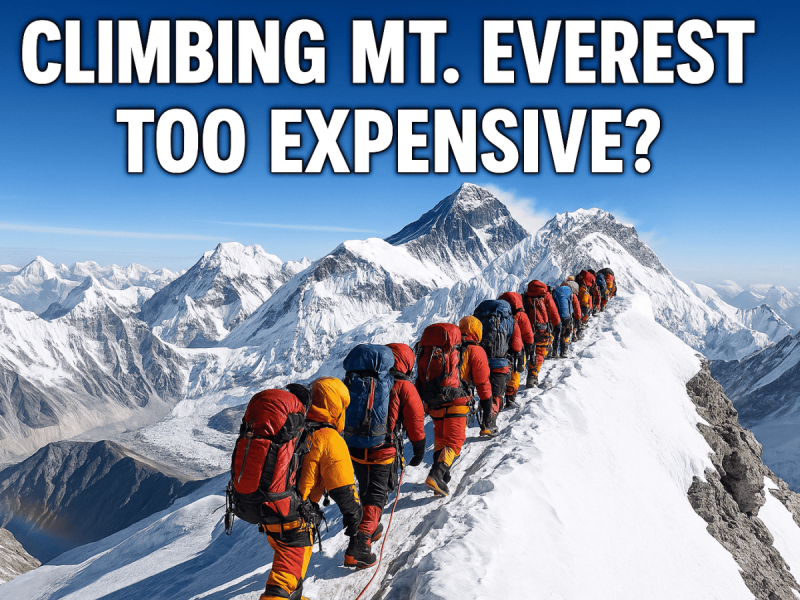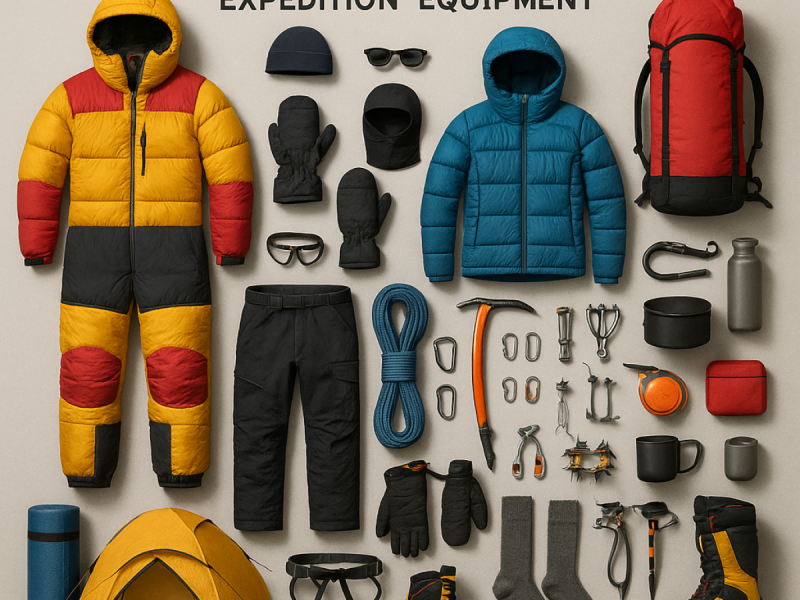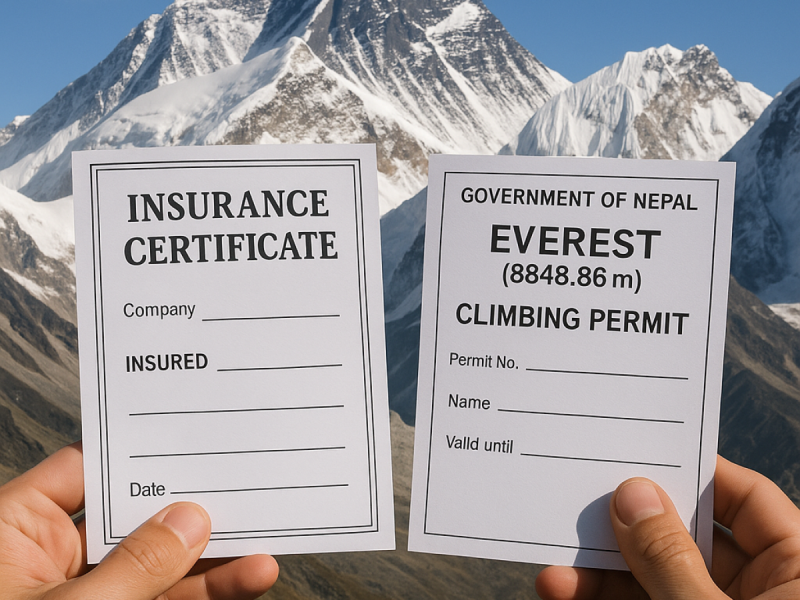
Climbing Mount Everest is more than just reaching the top of the world—it’s also one of the most expensive adventures out there. The total cost can vary a lot depending on the route you take, the gear you use, the guides you hire, and the insurance you need.
In this blog, we’ll break down how much it really costs to climb Mount Everest, step by step, so you’ll know exactly what you’re signing up for.
We’ll explore why the price can skyrocket, what expenses are absolutely necessary, and help you decide if the experience is worth the investment. You’ll also find helpful internal links to dive deeper into related topics—making this not just a guide, but a great starting point for anyone serious about Everest.
Climb Mount Everest in 2026, be prepared to spend anywhere from $40,000 to $100,000 per person. Most guided expeditions fall in the $55,000 to $75,000 range. The price depends on a few key factors—such as the reputation of the guiding company, whether it’s a full-service or budget operation, and the size of your group.
Luxury packages with extra Sherpa support, private tents, and special services can easily push the price up toward the $100K mark. Some even include perks like fixed-wing flights to base camp, gourmet meals by top chefs, and heated dining tents.
Timing also affects the cost. Climbing during the peak spring season is usually more expensive than going early or late in the season. Plus, things like permit limits, inflation, and new government rules are all pushing prices up. In fact, costs in 2025 are about 10–15% higher than in recent years due to more complex logistics, climate-related changes to the route, and tighter regulations.
Yes, you might come across budget trips under $50K, but those usually offer very basic services with limited safety support. For serious climbers, it’s often worth spending more on a trusted outfitter for better safety, experienced guides, and smoother logistics. Keep in mind that smaller groups often cost more per person, while larger teams can split many of the fixed expenses.
One of the biggest fixed expenses when climbing Mount Everest is the government permit. If you’re heading up from the Nepal side during the popular spring season that permit alone costs $11,000 per person. This fee gives you access from Base Camp to the summit. If you choose to climb from the Tibet side, the permit runs a bit lower—usually between $8,000 and $10,000—but once you add in visa fees, liaison officers, and service charges, the final cost often ends up being pretty similar to Nepal’s.
Keep in mind, the permit fee is non-refundable. So even if your climb gets canceled or you don’t reach the summit, you won’t get that money back. On top of that, there may be other mandatory fees, like environmental levies and waste management deposits. Delays due to weather or safety concerns? You’ll probably need to pay again next season.
Nepal also has specific rules, like requiring a minimum group size and following strict safety standards. Some tour operators might try to sidestep those rules to cut costs—but they’ll often charge you extra for the services needed to comply.
No matter whether you choose a budget or high-end operator, the government permit fee stays the same. But what comes with that fee can be very different. Some packages cover the cost of a liaison officer, environmental monitoring, and coordination with government bodies. Others just handle the bare minimum—paying the fee and moving on. That’s why it’s so important to read the fine print and know exactly what you’re getting.
If you’re thinking about climbing Mount Everest, one of the first big decisions is whether to go with a fully guided expedition or try a more independent approach.
A fully guided Everest climb usually includes just about everything—permits, experienced Sherpas, bottled oxygen, meals, tents, emergency support, even satellite phones. It’s a turn-key experience where the logistics, safety, and route planning are handled for you. But convenience comes at a cost: you’re typically looking at $60,000 to $80,000 per climber. The upside? You don’t have to stress about finding reliable gear, setting up base camp, or navigating permits—your outfitter handles it all.
Now, if you’re an experienced climber looking to save some money, the independent route might be tempting. On paper, it can cost less—maybe $30,000 to $50,000 depending on how you manage things. But that number can climb fast. You’ll need to organize your own permits, hire Sherpas, manage transport and food, and rent or buy critical gear like oxygen and communication devices. The DIY approach gives you more control—but also more work, risk, and hidden costs.
That said, some seasoned mountaineers actually prefer independence. It gives them more transparency on where their money’s going and lets them climb on their own terms. Still, it requires serious planning, strong local connections, and a high level of self-reliance. For most people, a guide-led expedition offers peace of mind—and while it’s pricier, you’re paying for safety, structure, and a smoother experience.

Climbing Everest demands serious gear—and it can get expensive fast. You’re looking at anywhere from $8,000 to $15,000 if you buy everything brand new. This includes essentials like expedition-grade down suits, high-altitude boots, -40°C-rated sleeping bags, mountaineering tents, ropes, stoves, and more.
But here’s some good news: a lot of climbers choose to rent gear in Kathmandu or even at Base Camp, which can significantly lower costs. You can rent oxygen tanks and masks, boots, harnesses, and down suits—cutting your upfront gear expenses to around $4,000 to $6,000.
That said, renting comes with trade-offs: possible wear and tear, hygiene concerns, or poor sizing. If you want the reliability of brand-new gear, plan for the extra cost (and baggage fees when flying in). Either way, quality matters—it can be the difference between a successful summit and turning back early due to frostbite or gear failure.
Tip: Before buying anything, check out our Mt. Everest Expedition Recommended Gear List. It’s packed with insights—like how to rate gear for warmth, durability, and even visibility (helpful for spotting teammates in whiteout conditions).
Also, consider investing in semi-custom or fitted gear, especially for your backpack, boots, and outerwear. Comfort at altitude isn’t a luxury—it’s survival.
You can’t just walk up Everest. Serious training is non-negotiable—and it can get costly. Depending on your starting fitness level, expect to spend anywhere from $2,000 to $10,000 on things like personal trainers, gym memberships, altitude training, and technical climbing practice.
Many climbers take on practice expeditions before Everest—smaller peaks in the Himalayas, Andes, or Alps. These help you test your gear, practice acclimatization, and build confidence. Each of these trips can cost $5,000 to $15,000.
Then there’s specialized training: ice climbing, crevasse rescue, high-altitude first aid. These courses typically run $1,000 to $3,000, depending on the location and length. Programs in Nepal, Europe, or the U.S. (like Colorado) are usually more budget-friendly than elite alpine courses in places like Switzerland or Alaska.
Some climbers also invest in altitude tents or hypoxic training systems, which simulate low-oxygen environments. Renting or buying one of these can cost $1,500 to $3,000, but they’re a great way to build up your body’s oxygen efficiency before the climb.
And don’t forget: guided multi-week training camps at high altitude are another great option. They help you meet other climbers, hone your skills, and mentally prepare for what’s ahead.
Bottom line? Whether you’re training in the gym, trekking in the Alps, or joining a Himalayan prep camp, investing in your training is investing in your success on Everest.
Hiring a Sherpa and guide support isn’t just a nice-to-have—it’s essential. In fact, after permits, this is usually the second-biggest cost of climbing Mount Everest.
An experienced Sherpa for a full expedition typically costs $15,000 to $25,000 per climber. This fee usually covers their own transportation, insurance, meals, and even their support crew. During the final summit push, it’s common to have 2–3 Sherpas assigned to each climber, especially if you’re using oxygen, which can double your Sherpa-related expenses.
Keep in mind that guide fees are separate. If you’re going with a Western guide—someone who’s summited Everest multiple times and is highly skilled—you’re looking at an additional $8,000 to $12,000. Top-tier expedition companies include a whole team of guides, whereas budget outfits may cut corners by having fewer staff or limited rescue resources.
There’s also tipping, which is an important and respected part of Everest culture. Sherpas generally receive 10–20% of their base pay in tips, with more given if they summit with you or go above and beyond, especially in harsh conditions.
What’s crucial is choosing a fair, ethical company. Ask questions like:
Do Sherpas receive proper accident and life insurance?
Yes, Sherpas working with licensed trekking and expedition companies in Nepal do receive accident and life insurance. Reputable agencies ensure proper coverage, which includes medical emergencies, rescue, and death benefits to protect Sherpas and support their families.
Are they paid a living wage?
Yes, our trekking staff, guides, and porters are paid fair wages that meet or exceed Nepal’s legal requirements. At Nature Heaven Treks and Expedition, we make sure they earn a living wage, with proper food, lodging, insurance, and equipment support during treks.
Do they get proper gear and full rest days at Base Camp?
Yes, trekkers get proper gear support and full rest days at Base Camp. Essential equipment like tents, sleeping bags, and food is provided, while rest days allow acclimatization, recovery, and preparation for the next stage of the climb.
These aren’t just technical details—they’re about safety, fairness, and respect. In the past, Sherpa deaths and poor treatment highlighted how risky their work can be. While conditions have improved, not all companies hold the same standards.
The bottom line? Without your Sherpa team, Everest is nearly impossible. They fix ropes, carry loads, break trail through deep snow, and lead you safely to the summit and back. Investing in strong Sherpa support isn’t just a financial decision—it’s one of the smartest and most respectful choices you can make on the mountain.

Getting to Everest is an adventure in itself, and the costs start long before you reach Base Camp.
First, there’s the international airfare. Prices vary depending on where you’re flying from, but you can expect to pay around $1,000 to $2,500 for a round-trip ticket to Kathmandu. From there, you’ll need to fly to Lukla, the gateway to the Everest region, or take a helicopter directly to Base Camp—both options add another $400 to $1,000 to your total.
Don’t forget to budget for your time in Kathmandu before and after the climb. Accommodation costs can range from $30 to $200 per night, depending on your preferences—budget guesthouses or high-end hotels, it’s up to you.
Now let’s talk about insurance—arguably one of the most important things to arrange. A comprehensive mountaineering policy that includes high-altitude rescue, helicopter evacuation, medical coverage, and trip cancellation is a must. Expect to pay $1,000 to $2,500 for a single expedition policy. High-altitude climbing isn’t covered by most basic travel insurance, so make sure your policy is specifically designed for mountaineering.
Some climbers, especially from places like Vietnam or Southeast Asia, also purchase additional local Nepali insurance to cover porters and Sherpa support staff. It’s a smart and respectful move to ensure your entire team is protected.
A sobering part of Everest planning is understanding emergency retrieval costs. In tragic cases where climbers pass away on the mountain, retrieving a body can be extremely dangerous and expensive—sometimes between $30,000 and $70,000, or even impossible. This is why climbers must carefully choose insurance and understand the real risks of high-altitude climbing.
Other important costs to factor in include:
Nepal visa fees: usually $50 to $125
Gear shipping or excess luggage charges
Pre-expedition meetings, briefings, and training
While some of these seem minor compared to guide fees or permits, overlooking even a small detail can jeopardize your entire expedition. So take the time to plan carefully—because when it comes to Everest, being prepared makes all the difference.
Even after you’ve budgeted for permits, guides, Sherpas, gear, and training, there are still some sneaky extra costs that can catch climbers off guard.
For starters, communication on the mountain isn’t free. Renting a satellite phone or getting data access can run you $500 to $1,000 per trip. If you need more bottled oxygen than what’s included in your package—or extra regulators—you could easily spend another $1,500 to $3,000, especially during the summit push.
Then there are the little comforts at Base Camp that don’t feel so little once they add up. Things like Wi-Fi access, charging your devices, or heated tents might seem minor, but together they can cost over $1,000 for the season.
Environmental costs are another hidden line in the budget. The Nepali government and many expedition operators require a garbage deposit or eco-fee, usually $500 to $1,000—and sometimes it’s non-refundable, even if you follow all the rules.
Now, here’s one of the most important (and often overlooked) factors: delays. Sudden bad weather or exhaustion during the descent can force you to stay put at high camps—sometimes for days. Every extra day means more oxygen, more food, more guide support, and sometimes more risk. Just one night stuck at Camp 2, for example, can cost $500 to $1,000.
Finally, you’ll want to set aside a serious emergency fund. Unexpected costs like medical treatment, helicopter rescues, or weather-related changes can be overwhelming. Most climbers wisely budget an extra 10–15% as a safety net, often amounting to $5,000 to $10,000—just in case.
On Everest, it’s not just the climb that’s unpredictable—it’s the costs too. Planning ahead and having a buffer gives you peace of mind so you can focus on the mountain, not your wallet.
After spending up to $100,000, you might wonder—is climbing Everest really worth it? For many climbers, the answer is a heartfelt yes.
The view from the summit is unlike anything else on Earth. But it’s more than just the scenery—it’s the sense of personal triumph, the proof that you faced one of the hardest challenges out there and came through. For some, it’s the fulfillment of a lifelong dream. For others, it’s the ultimate test of grit, endurance, and mental strength.
Those who’ve been there speak of “the sleeping beauty of Mount Everest”—not a fairytale, but a powerful reminder of nature’s awe-inspiring force. And even before the summit, moments stay with you. Sleeping at Everest Base Camp, under a sky full of stars with the sound of ice cracking nearby, becomes a memory etched into your soul.
But the risks are real. The Death Zone, above 8,000 meters, isn’t just a dramatic name—it’s a place where the body starts to shut down. Most climbers can only spend 30 to 60 minutes at the summit before they must head down. Any delay up there can be dangerous, and that’s why preparation, pace, and decision-making are everything.
In the end, climbing Everest isn’t just expensive in dollars—it asks for everything from you: your strength, your time, your heart. But if you go in prepared, with respect for the mountain and deep trust in your team, the reward isn’t just reaching the top—it’s everything you learn and become along the way.
From a distance—or even from space—Everest might just look like a white peak. But for those who’ve stood on it, it becomes a life-defining experience, and a reminder of how small we are in the vast, beautiful world we call home.
Climbing Mount Everest isn’t just expensive—it’s one of the toughest and most unforgettable journeys you can take. Between the $11,000 climbing permit, high-altitude insurance, Sherpa and guide support, gear, training, and all the little extras that add up along the way, a full expedition can easily cost $60,000 to over $100,000.
But for many climbers, that cost is more than just a number—it’s an investment in something life-changing. Because Everest isn’t just a mountain. It’s a personal challenge, a dream years in the making, and often, a moment that stays with you forever.
If you train smart, choose the right team, and go in prepared for the risks and rewards, the experience can shape your perspective in ways few other adventures ever could. At the top of the world, you don’t just stand on a summit—you stand in a moment that can redefine who you are.
Nature Heaven Treks and Expedition Nepal is known for its warm, personalized service and careful attention to every detail. They guide trekkers on unforgettable adventures through the stunning mountains and beautiful valleys of the Himalayas.
Call/WhatsApp/ Viber : +977-9851218358 | +977-9841937489
Email: info@natureheaventrek.com | natureadventure603@gmail.com
Address: Pakjonal Marga-16, Thamel, Kathmandu, Nepal
Website: https://natureheaventrek.com/
@Copyright 2025 Nature Heaven Treks and Expedition, Kathmandu, Nepal. All Rights Reserved.
Chat with Us